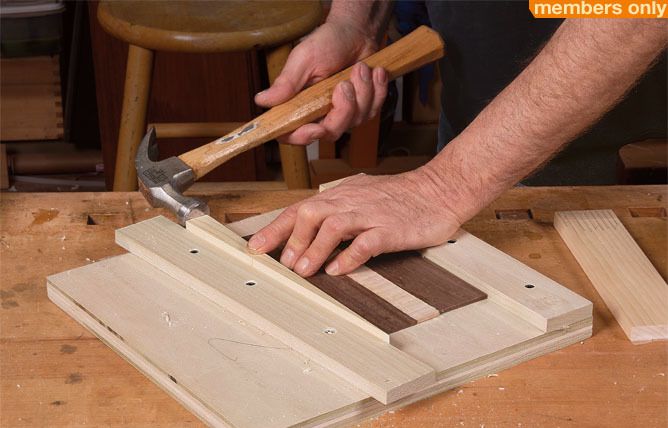The Versatile Wedge
Use these simple shop helpers to tackle tricky glue-ups, hold parts at the bench, and more.

Synopsis: Wedges are commonly used in joinery, but they also come in handy when clamping, especially in situations where traditional clamps get in the way or can’t do the job. They are also great for separating parts safely without damage. Bob Van Dyke makes his wedges from offcuts, or uses a jig if he needs a lot of the same type. He uses them to clamp thin panels, secure long edging to a workpiece, hold stock for edge-planing and routing, and take apart furniture for repair.
The wedge: I’m continually amazed at how something so simple can be so incredibly useful. It’s common to see wedges used in joinery, and they are the traditional way that a cutter is held in a hand tool like a handplane or cutting gauge. But I also find them really handy in certain clamping situations where traditional clamps are cumbersome or completely ineffective.
Not only is the force created by wedging action great when used to hold parts together, but that same force can also be used to safely separate parts with no damage.
I constantly find new purposes for wedges in the shop, even though they’ve been around as long as recorded history. Here I’ll show a few ways to clamp with wedges, a few ways to take things apart, and a few ways to hold work at the bench. once you’ve explored all the ways wedges can help you in the shop, you may think twice about buying another expensive specialty clamp.
They are easy to make
If you save offcuts from angled furniture parts like tapered legs, you might already have ready-made wedges stashed around your shop. When I do need a wedge that’s a certain size or with a specific slope, it’s easy to cut one or two wedges from the edge of a board on the bandsaw.
When I need multiple wedges of the same size and shape, I cut them on the bandsaw with a simple jig (see photos, below). Plane the stock to thickness and cut it to length, then place it in the jig’s notch and push it through the blade. Flip the stock end over end to cut the next wedge. For most clamping applications these bandsawn wedges will be ready to use right off the saw. But if the bandsaw leaves too rough a surface, clamp the wedges together in a vise and smooth them with a handplane.
 From Fine Woodworking #249
From Fine Woodworking #249
To view the entire article, please click the View PDF button below:
Fine Woodworking Recommended Products

Milescraft 4007 6in Bench Clamp

MicroJig Matchfit dovetail clamps

Dubuque Clamp Works Bar Clamps - 4 pack









Comments
Glad I picked up on this one..I often have to glue up thin boards, 1/4" and less. I wish I had read about the wedges just a few days ago. My table saw is an older Craftsman that uses slightly less than 1/8th" thick stock for inserts, but the stock is too narrow so I have to glue up two pieces of 8th" stock so the wedge jig will make this much easier from now on. Being so thin they wear out rather quickly. I have a few dozen 8th inch inserts and they get trashed quite often.
Log in or create an account to post a comment.
Sign up Log in